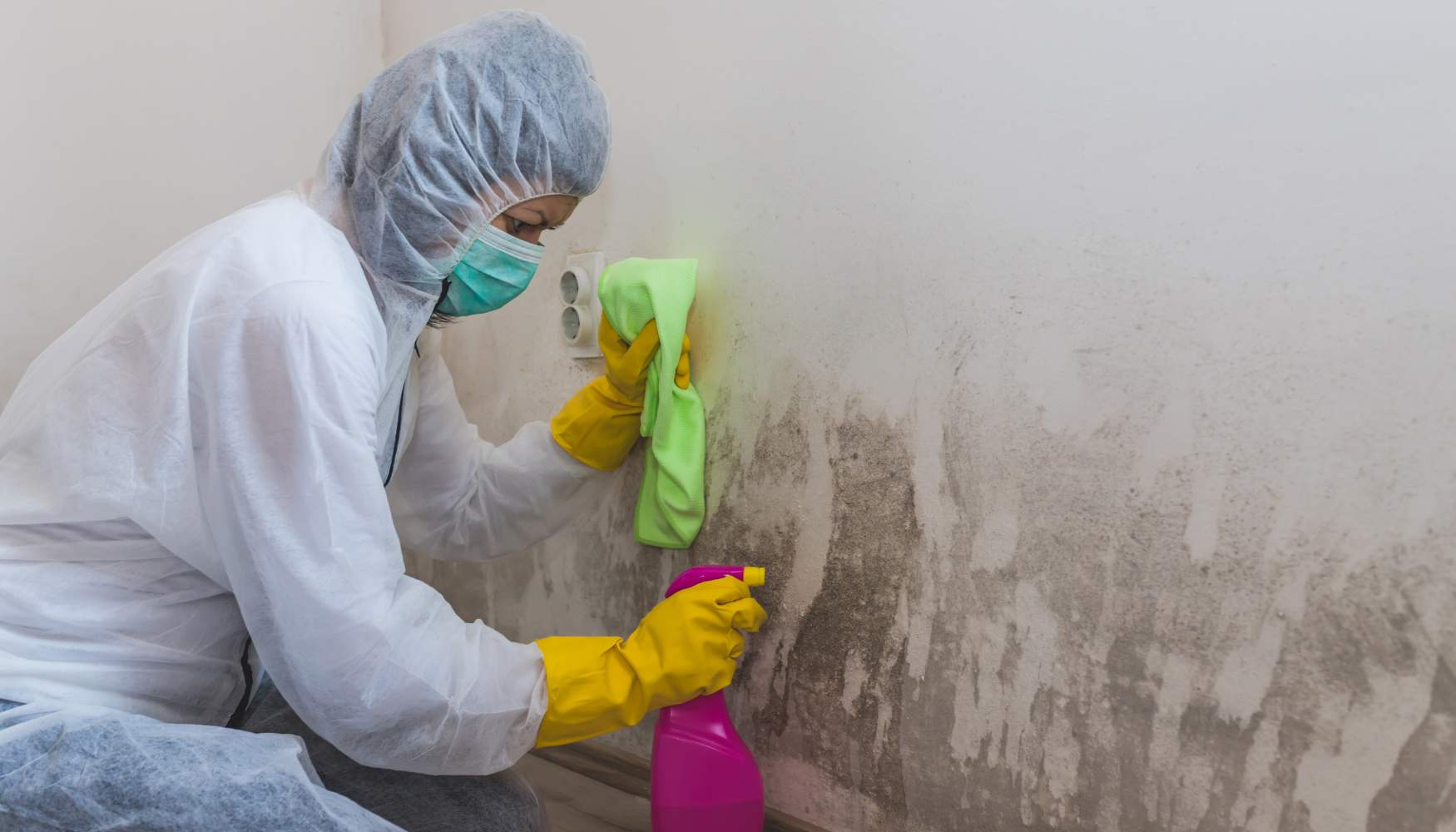“Do you smell that?”
“Is it the laundry?”
“I don’t think so, but what is it?”
Does this conversation happen at your home daily? Are you tired of living like you are in the movie Groundhog Day? Have you ever considered the cause of the smell could be mold?
It is common to smell a strange, musty odor when mold grows in the walls of homes and apartments — usually after a recent flood or leak.
Read on to learn what mold smells like and how to eliminate it.

Table of Contents
- How Do I Know if I’m Smelling Mold?
- What Does Mold in a House Smell Like?
- If You Smell Mold, Check These Common Places
- Eliminate Mold Odor With These DIY Tricks
- Let the Professionals at Pure Environmental Rid Your Home of Mold Odor
How Do I Know if I’m Smelling Mold?
Everyone perceives smells differently, but pay attention if something about how your home smells has changed.
Having an unpleasant or musty smell in your home is quite startling!
There might be mold in your house if your house has always smelled one way and suddenly does not.
What Does Mold in a House Smell Like?
Are you still asking, “What does house mold smell like?” Since smell is subjective, what mold smells like to one person might differ from another person.
Some of the more common smells include:
- Wet
- Earthy
- Musty
- Fermenting
- Rotting
- Tangy
- Sour
The reason for the smell is that mold is a living organism.
Are you looking for a professional to help with a mold odor problem? Look no further than Pure Environmental.
We can safely and effectively remove these odors from your home.
Contact us today for your free estimate.
Learn What Produces the Odor
How does mold smell? What happens to produce that intense aroma?
Mold needs three things to grow:
- Moisture
- Something to feed off of; and
- Time to grow
Gaseous chemicals are produced by fungal metabolism as the fungus grows and spreads. These chemicals are scientifically known as Microbial Volatile Organic Compounds (mVOCs).
There are over 200 mVOCs, and they all have different smells. Put these smells together, and you have the obnoxious smell of mold.
If You Smell Mold, Check These 5 Common Places
The presence of mold can affect your health in many ways. So when you smell mold, you need to find its source. Most likely, the mold is nearby where you’re smelling the odor.
Mold is commonly found in places where you have moisture and can become trapped.
If you’ve had any recent moisture events, such as water leaking, spilling, or intruding, pay special attention to those areas.
#1: Bathrooms
Taking a long, hot shower may be your favorite pastime, but mold also enjoys them. Mold multiplies in a bathroom’s warm, wet environment.
Checking for mold on shower tiles is obvious, but mold can grow in less obvious places in the bathroom, such as:
-
Bathtubs and showers — Mold spores will thrive if you do not ventilate during and after your shower or bath. Mold isn’t always visible; check shampoo bottles, washcloths and loofahs, shower curtains, faucets and shower heads, and tile grout for mold.
- Sinks and toilets — Sinks and toilets can develop mold because of the humid nature of bathrooms and the presence of water. When not cleaned and dried, the surfaces of the sink and toilet are the most likely places for mold to grow. Also, inspect the toothpaste and toothbrush caddies, the tank of the toilet, behind the toilet, underneath the bathroom sink, and all pipes for both sinks and toilets.
- Walls and floors — Pay attention to any water leaks from the walls or floors. These leaks can cause mold to multiply. Bathroom rugs are also known to harbor mold and are not washed as often as they should be.
#2: Kitchen
Whether it’s long-forgotten leftovers in the back of your fridge or dishes piling up in your sink, your kitchen offers plenty of surfaces for mold to grow.
Mold can grow quickly in the kitchen when humidity levels are increased by using the stove and running hot water.
There are several places in the kitchen where mold can be found:
- Kitchen sink — The kitchen sink is where a lot of things happen. Dishes pile up, food goes down the garbage disposal, wet sponges collect bacteria, and faucets run. Keeping an eye on these areas often will prevent mold from growing. In addition, check underneath the sink for evidence of leaky pipes.
- Refrigerator and pantry — Food, especially expired food, can cause mold. It is essential to keep your fridge and pantry free of old foods. Mold can also grow in fridge drip trays and water dispensers because they collect water.
- Microwave and stove — These food-centric places in your kitchen see a lot of food spillage and grease splatters, two things mold loves to call home.
- Dishwasher – In and around the dishwasher are common places where mold can hide. Be sure to look for moisture around your dishwasher and do routine cleanings of the inside.
#3: Bedrooms
In general, your bedroom may not appear to be a breeding ground for mold, and with proper humidity control, it may not be, either. However, mold can grow in any indoor space, so check for it.
In your bedroom, pay close attention to the following:
- Mattress — The thought of finding mold on your mattress is frightening. Consider investing in a mold-resistant mattress. If this is not an option, keep your mattress cool and dry and keep your household humidity low.
- Windows and window sills — In humid environments, windows that collect condensation can be especially problematic for preventing mold growth. It’s almost certain that mold will grow on the indoor window sill if moisture finds its way there. To be safe, if you see condensation on your window or window sill, wipe it off.
#4: Living Spaces
Mold can form in any room of your home, and living spaces are no exception. Mold growth is possible, from meals in front of the TV to household plants.
Be sure to pay special attention to the following:
- Fabric and upholstery — Fabrics and upholstery are great at collecting mold spores. You may smell a foul, musty odor if your couch (or other cloth-covered furniture) or curtains become moist. This should alert you to the presence of mold. Even if it’s not that noticeable, it’s wise to check.
- Fireplace and chimney — Fireplaces and chimneys are cool, damp, and dark when not used, making them magnets for mold spores. Since most fireplace bricks are porous, mold can spread quickly.
#5: Attic, Basement, and Garage
You probably don’t spend much time in these rooms in your home. As a result, not only are you less likely to notice mold, but mold is more likely to grow due to poor ventilation.
In these areas of your home, take the time to check the following:
- Ventilation systems
- Roof
- Insulation
- Sump pump
- Pipes
- Ducting
- Foundation
- Storage areas
- Furnace systems

It Might Not Be Mold — Common Household Odors Can Smell Similar to Mold
A horrible smell in your home does not necessarily indicate mold growth. Instead, a home can harbor all sorts of lingering and unpleasant aromas.
To eliminate the smell, be sure to check for these common household odors, which could resemble mold odor:
- Gas leaks
- Sewage backup
- HVAC issues
- Pet odors
- Rodents or pests
- Laundry
- Garbage
- Expired food
Eliminate Mold Odor With These 3 DIY Tricks
It is possible to eliminate mold odor by yourself. But isn’t it best to be safe rather than sorry?
Calling professionals is the best course of action.
At Pure Environmental, when we remove mold odor from your home, odors are a thing of the past.
Contact us today to get a free estimate on mold remediation services for your home.
#1: Use a Bleach and Water Mixture
Follow these steps when using a bleach and water mixture:
- Put on gloves and goggles.
- Use one cup of bleach per gallon of water.
- Utilizing a spray bottle, bucket, sponge, or cloth, apply the solution to non-porous surfaces with mold growth.
Feel free to scrub all around the house if you cannot narrow down the smell.
As the bleach inhibits mold growth in the future, there is no need to rinse the surface afterward.

#2: Wash in the Laundry
Mold found on washable fabric can be washed in your machine with some prep work.
Follow these steps to treat mold before washing:
- Ensure the clothing item is free of excess spores by brushing it off. Next, brush both sides of the clothing to remove the fungus spores. Here’s a tip: Do this step outside!
- Grab any mold-cleaning detergents in the market and soak the mold-infested clothing for about 15 minutes.
- After you have soaked the fabric, add bleach to the mold-stained area. You can use chlorine bleach on cotton fabrics that are 100% pure cotton, as it does not affect the white color. You can break down mold components on color fabrics with pure phenol disinfectants without damaging the colors.
- Now it’s time to wash the fabric as usual. If the moldy stain persists, repeat this method as needed to remove it.
Ensure your washer is cleaned thoroughly to remove mold spores or odors.
#3: Use Odor Absorbers
Your first instinct when you notice strange odors in your home may be to reach for an air freshener. However, even the best air freshener will not eliminate mold smells.
Instead of reaching for an air-freshener, try these instead:
- Cat litter
- Charcoal briquettes
- Baking soda; or
- Vinegar with a few drops of essential oil
It is important to replace these regularly. You should replace one a month.
Let the Professionals at Pure Environmental Rid Your Home of Mold Odor
As well as looking gross and smelling musty, mold can be unhealthy for you and your family.
For mold remediation and air purification in Portland, OR, and Tacoma, WA, and surrounding areas, call Pure Environmental. We are highly skilled at mold remediation. If you have a mold problem anywhere in your home — from the basement to the attic — we can help!
To ensure your space is mold-free, we ensure the abatement process is comprehensive.
We can also help with the following:
- Odor removal
- Bed bug treatment; and
- Disaster Restoration
If you need any of those services, contact us today.
Recent posts
- Maximize Comfort & Savings: Make Your Attic More Energy Efficient Today
- How To Prevent Water in Your Crawl Space: Proven Strategies To Prevent Water Damage
- Fresh and Clean: How To Disinfect the Air in Your Home Naturally
- Pros and Cons of Heat Treatment for Bed Bugs: Things To Consider When Reviewing Your Options for Remediation
- How To Get Rid of Pet Odor in Your House
Recent Posts
- Maximize Comfort & Savings: Make Your Attic More Energy Efficient Today
- How To Prevent Water in Your Crawl Space: Proven Strategies To Prevent Water Damage
- Fresh and Clean: How To Disinfect the Air in Your Home Naturally
- Pros and Cons of Heat Treatment for Bed Bugs: Things To Consider When Reviewing Your Options for Remediation
- How To Get Rid of Pet Odor in Your House
